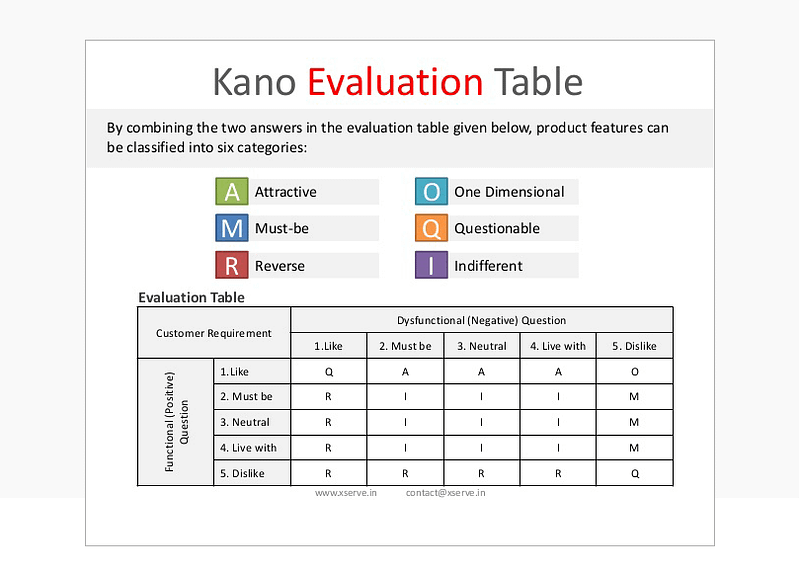Kano: The customer-driven prioritization technique
The Kano technique was created by the Japanese researcher Noriaki Kano in the 1980s. In a nutshell, it’s a way to identify different kinds of product features and measure their presence (or absence) against customer satisfaction.
Kano’s Model shows that some types of features will never create positive satisfaction in users, even if they’re good features. Some features, Kano’s ‘basic’ features, will only create a feeling of neutrality if present, but disgust if absent.
Features
The most fundamental Kano model implementation and go-to version suggest dividing user backlog points by five criteria:
Must-Be: The customers consider the product functional only if these features are included.
Attractive: Features in this section add extra satisfaction, or even enjoyment and gratification. Basically, they are unexpected but nice-to-have features. On the other hand, their absence doesn’t leave customers dissatisfied.
One-Dimensional: These features have a dual nature. While they aren’t a must for a product to work, they remain extremely desirable to customers. The category is closely related to foreseeing customer needs and expectations. When a product includes what customers would be happy to get, they stay satisfied. But if you fail to deliver them, users are more likely to experience disappointment.
Indifferent: The attributes here represent the least possible impact on customer satisfaction. In a nutshell, they have no value.
Reverse: The features falling into this category are considered to be the most annoying. Their presence has a rather negative effect on customer satisfaction. Alternatively, when they are not introduced, customers consider it a plus.
As the method revolves around user satisfaction and is based on user opinion, it requires conducting Kano surveys and user interviews before prioritization practice.
Applying the Kano Model
As both product and UX teams are aware, conducting effective research into user satisfaction is a skill all of its own. The Kano Model comes with its own questionnaire to facilitate the process of discovering user satisfaction levels.
Like the Model itself, the questionnaire is disarmingly simple. For every feature the product manager must ask the user two questions:
How would you feel if the product had that feature?
How would you feel if the product didn’t have that feature?
Users can choose pre-selected responses, ranging from ‘I like it’ to ‘I don’t like it’.
Using the responses, product managers can categorize each feature in an evaluation table, like the one below.
Via: Nitesh Verma
Even though the Kano questionnaire is simple it can reveal useful data.
Pros of the Kano model
Highlighting the potential strengths and weaknesses of a product. One of the most valuable features of the Kano model is user feedback. The results of the Kano questionnaire help realize the future product’s advantages and disadvantages. It allows product managers to specify the product/market fit early in development.
Ranking product features by their value for customers. The Kano model helps rate the product properties from the value proposition standpoint and tailor it to user needs.
Cons of the Kano model
Provides no details on resources required. Although the Kano model gives a more comprehensive picture on how to establish the priorities from the customer vantage point, it doesn’t account for time and costs that are necessary for a given release or a particular feature.
Time-consuming practice. Since the Kano model originally involves the Kano survey, which may target a lot of potential customers, the efforts to process and estimate the results might be quite significant. It slows down the time-to-market and, consequently, distracts the team from execution.
Restricted by customers’ opinions and knowledge. The backlog may introduce a plain wishlist and be limited to the expectations of customers who have no technical background. This caveat can lead to unstable releases. To make Kano efficient, you have to discuss the technical concepts separately.
Lessons For Product Managers
Define your users’ needs in light of the Kano model. What are the basic expectations that they simply expect to be there and where would the absence of these features lead to frustration?
Map your products and features against the Kano model. Which features are meeting basic expectations? Only invest in developing or maintaining those to the extent that you need to satisfy the customer. Which features are your delighters? Focus your efforts here and make sure you’re constantly developing new ones.
Monitor your customer satisfaction and competition to ensure that features you think delight users haven’t slid into basic expectations and no longer help your customer satisfaction.
Find and focus on sustainable delighters that truly differentiate your product and continue to deliver customer satisfaction over time.
When to use the Kano Model
If you are a startup striving to generate user feedback for the initial UX design, it will be quite efficient to submit your concept in tandem with the Kano survey. Given that it’s always better to demonstrate than describe, the combination of a prototype and the questionnaire will help distill the value. But if your product entails technical complexity and various hidden blockers, you should balance Kano or completely substitute it with more specific methods.



